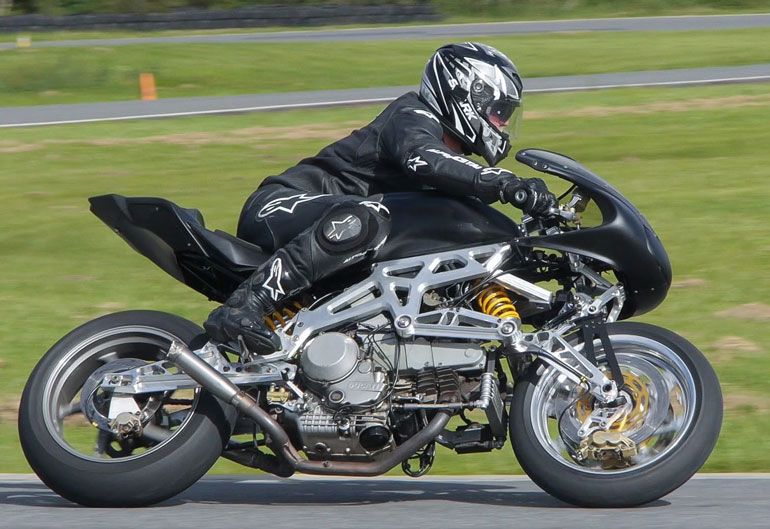Throttle jockeys, rejoice! One Australian has created an innovative motorcycle design that makes for a smoother and more stable ride.
Every bike rider knows that touching the brakes or easing off the throttle too much in a corner can mean catastrophic results. But an Australian enthusiast has created a unique motorcycle design to address this issue. How? He fine tuned the forks to allow for braking and throttle changes mid-corner.
The triangulated steering and suspension system (TS3) by Motorcycle Innovation (Motoinno) does this by replacing a bike’s telescopic forks, which can cause a multitude of problems.
“It’s not a stable platform to ride on. That’s one of the biggest detrimental factors with the whole thing and that’s what people have been trying to figure out and improve over the last 50 or 70 years since they were invented,” said Ray Van Steenwyk, director of Motoinno and the system’s inventor.
Van Steenwyk designed the system when he came back from a work trip in China and suffered from chronic fatigue syndrome – all he could do was think and draw.
At the time, he was buying old antique motorbikes and refurbishing them and thought about how to design a better front-end system. He experimented with some different designs, but couldn’t come up with a workable system and forgot about it.
When he was due to move back overseas for work, he came across his designs while he was packing up.
“I do my designs one way first and then I turn the book upside down and do more designs the other way. When I looked back at one page, there were two designs on the one page that actually, if you put them together, they came up with the configuration that I’ve got now,” he said.
One problem with telescopic forks on a motorcycle is there is not always enough room for a bike to absorb several impacts at once. For example, bumps in the road can cause the bike’s suspension to collapse, with no further compression left to handle other road problems.
“So as soon as that happens, because (telescopic forks) flex horizontally and laterally, it sets up an oscillation harmonic in the front wheel and that gets transferred back into the headstock of the bike,” Van Steenwyk said.
“That’s what a big tank slap is. Once that starts to happen, if you go off the throttle the vibration just continues.”
This can cause a rider to high side – go up and over the bike.
At the other end of the spectrum, one cause of low speed accidents – a low side – is going off the throttle as a rider heads into a corner.
This meant a solution needed to improve the bike’s stability and get rid of oscillation harmonics, which Motoinno has achieved through the unique triangular design that doesn’t flex horizontally or laterally.
Motoinno’s system can also be customised to any compression percentage – Van Steenwyk said its current prototype is set at 25 per cent dive to give the rider feedback about the bike.
“Under normal braking we’ve got 25 per cent of dive, but under emergency braking, the whole system goes neutral, so you’ve still got 75 per cent of your suspension travel under bumps, and that’s what makes it very, very stable,” he said.
“But if you go further than [25 per cent], it’s detrimental to the whole system. You want to retain your suspension for bumps that are coming up.”
The suspension provides so much stability that Van Steenwyk said riders can even chop the brake mid-corner – a death wish for any rider on a standard bike – and it won’t throw them off.
Van Steenwyk had experience using animation software for his work, so his first step involved designing the system in an animation program.
“If you change one thing on a fork bike, you change a myriad of things throughout the whole bike,” Van Steenwyk said.
This meant redesigning everything on the bike to see how it worked.
Van Steenwyk then needed to teach himself basic engineering about motorbike suspension, which he did over a four-year period, and how to use CAD.
“Because I’ve worked in animations so long, we have to build everything to real world standards, so that gave me an understanding of the principles of engineering. Then it was just a matter of learning the CAD programs and putting in what I know from animation back into CAD,” he said.
After he had designed the system, a machinist built all of the components out of aero grade aluminium and Van Steenwyk bolted the bike together using a Ducati 900 SS motor because it still had hard points that the front-end system could bolt onto. V-twin motors are also suited to the Motoinno system because of their narrow shape, but the TS3 can be used on other motor types, even electric vehicles.
“Once you’ve got your weight distribution set up and know where your engine should be in the overall chassis, any engine will react in the same way, so it’s quite easy to transfer the technology onto any other motorcycle engine,” Van Steenwyk said.
The first test for the prototype was carried out on old police track in Sydney that comprised corners of different radiuses and cambers. Van Steenwyk said he remembers feeling a lot of trepidation.
“I didn’t know if the bike was over-engineered or under-engineered, but as we got on the thing, it handled very well, even though the suspension was not set up properly for the whole bike,” he said.
“It was a very exciting time. I remember getting off the bike and thinking, ‘This is incredible – I’ve never ridden anything that feels like this,’ and I’ve been riding since I was about 16.”
The road ahead
Since then, the prototype has undergone numerous tests, including a test run at Eastern Creek by Cameron Donald, a professional motorbike rider who has competed in the Isle of Man.
Motoinno has now spent more than $300,000 refining the prototype, with funding including a $50,000 Federal Government innovation grant. It is now at a stage where it could go straight into production using a Ducati engine, with the final version of the bike to use a water-cooled Ducati 2014 Monster 1200 Testastretta engine.
Motoinno’s ultimate goal is commercialisation. Its strategy to get there includes three stages – getting the system tested in race conditions; developing a high-end boutique bike; and commercialisation.
Motoinno is currently working on the first stage of the strategy and are in discussions with a race team in Australia for Moto2, a class of the MotoGP that uses 600 cc bikes.
One of the main challenges of adapting the Motoinno system to a race bike will be looking at how it reacts at higher speeds – although the prototype has reacted well to normal road speeds, how it will handle 320-350 km/hr speeds is unknown.
“Theoretically, if we don’t suffer any engineering or design problems like materials breaking, then we should be able to be very competitive, if not better than what’s being raced at the moment,” he said.
Motoinno is also in discussions with an Australian motorcycle manufacturer that plans to build a 650 cc bike.
The second stage includes building a boutique bike that would have a run of 10 units and be sold for $150,000-200,000. The bike would be made entirely of carbon fibre and titanium, which would bring down the weight from 161 kg to 110 kg.
Stage three of the plan – commercialisation – could be as soon as 6-12 months off.
“If we can prove (the TS3’s benefits) and we start getting very good results, that should actually push us further into commercialisation because manufacturers will have to start taking notice, riders will actually realise there is a better system out there and investors will turn around say ‘This is a pretty good thing to start getting onto it’,” Van Steenwyk said.



